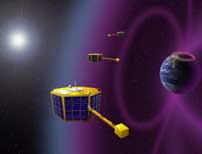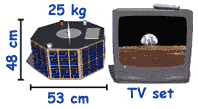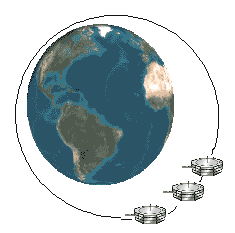The Space Technology 5 mission, launched March 22, 2006, and completed June 20, 2006, focused on the design, development, integration and operation of three full service 25-kilogram-class spacecraft that implemented multiple new technologies, functioned as a single constellation, and achieved accurate research-quality scientific measurements.
At Goddard Space Flight Center (GSFC), the Space Technology 5 (ST5) Project advanced the technology of miniaturizing smart and powerful electronic gadgets by building and testing three small satellites, also known as micro-sats. Development of these satellites tested and validated new technologies and manufacturing techniques. In addition, the mission contributed to scientists' understanding of the harsh environment of Earth's magnetosphere
 |
Artist's concept of ST5.
|
The ST5 Project is part of the New Millennium Program (NMP). NMP was created to identify, develop, build, and test innovative technologies and concepts for infusion into future missions. To select which capabilities will be needed, NMP is guided by NASA's Earth and Space Science "roadmaps." These roadmaps lay out the path of future scientific enquiry. They serve not only as a vital guide for NMP's selection of technologies, but are used to conceive and design the Program's test missions as well.
 |
Not much bigger than a large birthday cake or a small TV.
|
At GSFC, miniaturized redundant components and technologies were integrated into each of the micro-sats. Each micro-sat weighed approximately 25 kilograms (55 pounds) when fully fueled and resembled a very large birthday cake at 53 centimeters (20.7 inches) across and 48 centimeters (18.7 inches) high. The ST5 Project also built the spacecraft bus that enabled the mission's multiple micro-sats to be launched from a Pegasus XL rocket and spun into a near-Earth polar orbit of approximately 4,500 kilometers (2,796 miles) altitude.
Although smaller than any of their previous counterparts, each of these satellites is considered "full service," meaning it carries guidance, navigation and control, attitude control, propulsion, and high bandwidth and complex communication functions. In addition, each ST5 micro-sat validated NMP selected technologies, such as the Cold Gas Micro-Thruster (CGMT), X-Band Transponder Communication System, Variable Emittance Coatings for Thermal Control, and CMOS Ultra-Low Power Radiation Tolerant (CULPRiT) Logic.
 |
Space Technology 5 satellites stacked for launch from a Pegasus XL rocket
|
Another value-added feature as a result of their miniaturize size and reduced weight is the ability to launch multiple micro-sats from one low-cost Pegasus XL rocket. The ST5 Project designed, fabricated, and tested a new innovative Pegasus launch rack that supports three micro-sats in a "stacked" configuration. This multi-rack design allowed each micro-sat to be individually deployed in a spinning motion.
After deployment, the micro-sats were positioned in a "string of pearls" constellation that demonstrated the ability to position the micro-sats to perform simultaneous multi-point measurements of Earth's magnetic field using highly sensitive magnetometers. Using data collected from the ST5 constellation, scientists can begin to understand and map the intensity and direction of the magnetic field, its relation to space weather events, and the affects on our planet.
 |
Space Technology 5 satellites in their
"string of pearls" orbit
|
With the help of pathfinder missions such as ST5, NASA hopes to improve scientists' ability to accurately forecast space weather and thereby minimize its harmful effects on space and ground based systems.
The mission, launched from Vandenberg Air Force Base, lasted 90 days, as planned.
Small, inexpensive, yet highly capable micro-sats such as these are instrumental in the validation of new miniaturized components that will help pave the way for flying tens to hundreds of micro-sats in future missions.